Giant scorpiochs, a winged horse, the evil Medusa, effervescent characters, digital cities and an enormous Kraken are just some of the visual effects realised in director Louis Leterrier’s remake of Clash of the Titans. We hone in one some of the main effects work by Cinesite, Framestore and MPC.
Cinesite – the scorpiochs
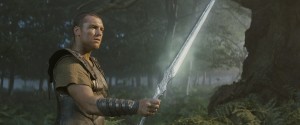 After discovering he is the mortal son of Zeus, Perseus (Sam Worthington) journeys to Argos in the hope of stopping the underworld from taking over the Earth and the Gods to a final confrontation with the Kraken. On the way, Perseus and his crew are attacked by Calibos, whose hand is severed in the fight. Calibos’ blood forms giant scorpion-like creatures – scorpiochs – which rise from the sand and attack the group. Cinesite completed nearly 100 shots for the resulting scorpioch battle sequence, working from the script and scene-setting illustrations provided by Aaron Sims and guidance from production visual effects supervisor Nick Davis.
After discovering he is the mortal son of Zeus, Perseus (Sam Worthington) journeys to Argos in the hope of stopping the underworld from taking over the Earth and the Gods to a final confrontation with the Kraken. On the way, Perseus and his crew are attacked by Calibos, whose hand is severed in the fight. Calibos’ blood forms giant scorpion-like creatures – scorpiochs – which rise from the sand and attack the group. Cinesite completed nearly 100 shots for the resulting scorpioch battle sequence, working from the script and scene-setting illustrations provided by Aaron Sims and guidance from production visual effects supervisor Nick Davis.
Cinesite visual effects supervisor Simon Stanley-Clamp led a design effort at the studio to work out how big the creatures needed to be. “The script was pretty brief: blood drips, hand transforms into scorpioch, battle ensues. So we went about designing our creatures in Mudbox and I photoshopped them together to show Louis. There was a period where they looked a little too much like lobsters or crabs, and we had to work on the claws and the pincers so they didn’t look too marine-based.” Six scorpiochs featured in the battle, ranging from 15 to 60 feet, all as variations of the mother creature. The scorpiochs were also subtleley colour-coded to match their environment so that creature surfaces would change depending on if they were traversing rocky terrain, a sandy desert or in a blue/grey slate mine.
For reference, a Cinesite crew visited a reptile farm that kept scorpions in the English Midlands to capture footage and photograph textures. “We also bought two scorpions and kept those at our 2D lead’s house because we weren’t allowed to have those in the building here,” recalled Stanley-Clamp. Artists then developed some scorpioch walk cycles derived from the real scorpions and video on the web. “The brief as it developed from Louis was a kind of powerful, massively athletic animal, like a charging rhinoceros. We had to slow everything down to make our creatures look heavy enough.”
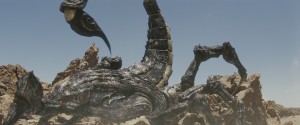 Modeling of the scorpiochs initially took place in Mudbox, with animation completed in Maya and rendering in RenderMan. “There was nothing too horrendous about the models,” noted Stanley-Clamp. “We’ve done lots of creatures, including spiders, before. For the tail we adapted the rig to make it flexible enough but not over-flexible so that it wouldn’t intersect with the rest of the body. You could get some extreme moves, the stinger could come right over the head of the scorpioch and reach right in front of it. In fact, there’s a couple of shots where it stabs one of the soldiers in the back.” Animators relied on keyframes rather than procedural methods to bring the creatures to life. More complex modeling and rigging was necessary for later shots of tamed scorpiochs carrying Perseus’ crew. “One of the tricker things was in the travel sequence where there’s a palanquin on the back of the scorpioch like a giant tent on an elephant. When we modeled and rigged that, it had to flex and sit on the back of the scorpion, but it also had its own rig to constrain the tail so that it would look like it was being tied down by ropes.”
Modeling of the scorpiochs initially took place in Mudbox, with animation completed in Maya and rendering in RenderMan. “There was nothing too horrendous about the models,” noted Stanley-Clamp. “We’ve done lots of creatures, including spiders, before. For the tail we adapted the rig to make it flexible enough but not over-flexible so that it wouldn’t intersect with the rest of the body. You could get some extreme moves, the stinger could come right over the head of the scorpioch and reach right in front of it. In fact, there’s a couple of shots where it stabs one of the soldiers in the back.” Animators relied on keyframes rather than procedural methods to bring the creatures to life. More complex modeling and rigging was necessary for later shots of tamed scorpiochs carrying Perseus’ crew. “One of the tricker things was in the travel sequence where there’s a palanquin on the back of the scorpioch like a giant tent on an elephant. When we modeled and rigged that, it had to flex and sit on the back of the scorpion, but it also had its own rig to constrain the tail so that it would look like it was being tied down by ropes.”
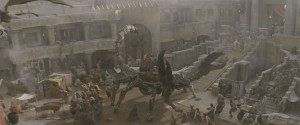 Production shot the scorpioch battle over three weeks in a national park in Tenerife at the foot of a volcano. The location was divided up into areas to accommodate three separate mini-battles, with Stanley-Clamp sharing supervisory duties with Nick Davis. “Although we had done some previs, performance-wise on location they worked mostly blind,” said Stanley-Clamp. For a sequence in which the character Draco jumps onto the back of a scorpioch, an eight-axis motion base on location was shipped out to the location after being programmed with Cinesite’s previs animation. “At the end of the day, Neil Corbuld’s specialist blokes puppeteered it live on set, recorded the data so we could repeat it for multiple takes and then we brought that data back to London to help with tracking and matchmoving our CG scorp back over the rig.”
Production shot the scorpioch battle over three weeks in a national park in Tenerife at the foot of a volcano. The location was divided up into areas to accommodate three separate mini-battles, with Stanley-Clamp sharing supervisory duties with Nick Davis. “Although we had done some previs, performance-wise on location they worked mostly blind,” said Stanley-Clamp. For a sequence in which the character Draco jumps onto the back of a scorpioch, an eight-axis motion base on location was shipped out to the location after being programmed with Cinesite’s previs animation. “At the end of the day, Neil Corbuld’s specialist blokes puppeteered it live on set, recorded the data so we could repeat it for multiple takes and then we brought that data back to London to help with tracking and matchmoving our CG scorp back over the rig.”
The director utilised a long carbon fiber rod with a ping pong ball on the end to show the size of the scorpiochs and the eyelines. “A lot of the performance,” noted Stanley-Clamp, “came from Louis with a massive carbon fibre rob and a ping pong ball at the end of it saying, ‘I’m a scorpion, that’s your tail, that’s your eyeline!'” Some shots also relied on a stuntman in a green jumpsuit with a long stick and a sponge on the end for Sam Worthington to hit against and stab his sword at. Cinesite augmented columns on the set that were destroyed when the scorpiochs swiped at them with their claws or tail. “For those shots, we had a fair bit of pyro and partial columns. We did some CG ‘top-ofs’ and then back in post blew the top of the column away and added more physical debris into the shots.” One shot of a wall exploding, filmed with a practical set-piece and pyro explosion, was replaced in post with a CG wall and digital debris to allow a more dynamic move.
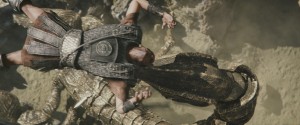
A significant part of Cinesite’s work for the scorpioch battle involved adding dust kicked up from the creatures’ legs and tails, although this was not something that had initially been considered. “In the script,” said Stanley-Clamp, “the scorpiochs come out of the ground and we thought it was going to be hard, mud-like volcanic ground which would crack in big plates. So we did our early tests based on that in some lovely previs which Louis saw and said it was great. Then I went out on location before the shoot and it was nothing like that at all. The ground was full of small pumice and very dusty. That was a big re-think. I came back and realised we would have to really work up on the effects and particles side of things. Plus, the DOP loved the dust – back-lit dust, very atmospheric – you get some super shots, God-rays, all manner of luscious lighting effects. The kind of thing where you’d probably pump smoke into the place, but we didn’t need to because there was just dust everywhere.”
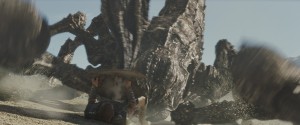 Cinesite generated dust using Houdini and Mantra to represent the scorpiochs stamping their feet, with pumice material falling off their bodies. “For every foot-fall, slide and punch, there were three integrated passes rendered out,” said Stanley-Clamp. “It was nice because the sand gives you the texture, dust gives you the atmospheric and the gravel is a bigger physical entity and helps describe the weight of the scorpions as they jump and skid. You get a whoosh of stuff being flung everywhere.” Final compositing was shared between Shake and Nuke. Ultimately, Cinesite benefited from production turning over the plates straight away from the first rough cut. “They were full plates rather than just telecines or Avid plates,” said Stanley-Clamp. “So we had a chance to do rough tracks and rough comps for the first cut, deliver those back to production and then could hone the edit. Otherwise, it’s just a bunch of guys running around the desert fighting empty space. We were prepared to do more than 200 shots and have not all of them make the cut, but it worked better in terms of editing.”
Cinesite generated dust using Houdini and Mantra to represent the scorpiochs stamping their feet, with pumice material falling off their bodies. “For every foot-fall, slide and punch, there were three integrated passes rendered out,” said Stanley-Clamp. “It was nice because the sand gives you the texture, dust gives you the atmospheric and the gravel is a bigger physical entity and helps describe the weight of the scorpions as they jump and skid. You get a whoosh of stuff being flung everywhere.” Final compositing was shared between Shake and Nuke. Ultimately, Cinesite benefited from production turning over the plates straight away from the first rough cut. “They were full plates rather than just telecines or Avid plates,” said Stanley-Clamp. “So we had a chance to do rough tracks and rough comps for the first cut, deliver those back to production and then could hone the edit. Otherwise, it’s just a bunch of guys running around the desert fighting empty space. We were prepared to do more than 200 shots and have not all of them make the cut, but it worked better in terms of editing.”
Framestore – Medusa, Hades and Olympus
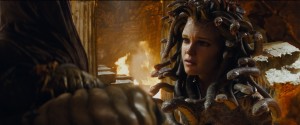 Another creature Perseus encounters is the mythical Medusa, conceived as half-woman and half-snake and featuring an iconic hair of slithering snakes, with the ability to turn people to stone. Perseus defeats Medusa, knowing her prized head will be able to help him defeat the Kraken. Framestore created Medusa entirely in CG and augmented her lair which had been shot as a built set. “There was a lot of concept work done for how Medusa’s snake body changed into the human body,” explained Framestore visual effects supervisor Tim Webber. “We were trying to get a very gradual transition so that it didn’t look like a human person was stuck on top of a snake body, but it felt like it merged from one to the other. We ended up modeling subtle hints of stomach muscles and hips.” Reference photos and footage of supermodel Natalia Vodianova were used to model Medusa. “We used the reference of Natalia and a Facial Action Coding System (FACS) model and built a complicated rig to animate her facial performance.” Both ZBrush and Maya were relied on for the modeling with animation completed in Maya.
Another creature Perseus encounters is the mythical Medusa, conceived as half-woman and half-snake and featuring an iconic hair of slithering snakes, with the ability to turn people to stone. Perseus defeats Medusa, knowing her prized head will be able to help him defeat the Kraken. Framestore created Medusa entirely in CG and augmented her lair which had been shot as a built set. “There was a lot of concept work done for how Medusa’s snake body changed into the human body,” explained Framestore visual effects supervisor Tim Webber. “We were trying to get a very gradual transition so that it didn’t look like a human person was stuck on top of a snake body, but it felt like it merged from one to the other. We ended up modeling subtle hints of stomach muscles and hips.” Reference photos and footage of supermodel Natalia Vodianova were used to model Medusa. “We used the reference of Natalia and a Facial Action Coding System (FACS) model and built a complicated rig to animate her facial performance.” Both ZBrush and Maya were relied on for the modeling with animation completed in Maya.
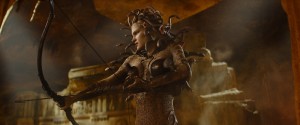 Medusa’s lair was built and shot as a modular set, with multiple layers composited by Framestore to create the final look. Artists relied on image-based lighting reference and a LIDAR scan of the set. “When the characters look over the edge,” said Webber, “they’re just looking the studio floor but we would extend the layers down below going down to lava. And similarly looking up. So what was actually a fairly normal sized set appeared to be a massive environment.” For Medusa’s hair of snakes, Webber considered automatic techniques for animation but went with hand animation to get the necessary level of performance. “We’d just done some snakes on Prince of Persia and had come up with a clever system for adding scales to the body of the snake that were made out of geometry and were hinged so that they could slide over each other. It had to be quite enhanced because Medusa is so large – the way the system had to work was quite technically complex and needed some R&D.” To turn people in stone, Framestore matched practical life casts of the actors in CG to exact poses, manipulating a change in state to give an interesting look. “It wasn’t just a dissolve – we made it grow in a vein-like fashion starting at the eyes and out from there. A lot of that was done in compositing, using Nuke’s 3D capabilities.”
Medusa’s lair was built and shot as a modular set, with multiple layers composited by Framestore to create the final look. Artists relied on image-based lighting reference and a LIDAR scan of the set. “When the characters look over the edge,” said Webber, “they’re just looking the studio floor but we would extend the layers down below going down to lava. And similarly looking up. So what was actually a fairly normal sized set appeared to be a massive environment.” For Medusa’s hair of snakes, Webber considered automatic techniques for animation but went with hand animation to get the necessary level of performance. “We’d just done some snakes on Prince of Persia and had come up with a clever system for adding scales to the body of the snake that were made out of geometry and were hinged so that they could slide over each other. It had to be quite enhanced because Medusa is so large – the way the system had to work was quite technically complex and needed some R&D.” To turn people in stone, Framestore matched practical life casts of the actors in CG to exact poses, manipulating a change in state to give an interesting look. “It wasn’t just a dissolve – we made it grow in a vein-like fashion starting at the eyes and out from there. A lot of that was done in compositing, using Nuke’s 3D capabilities.”
Framestore also delivered shots of Hades (Ralph Fiennes), the brother of Zeus, who would appear in scenes often with a burning cloak or black ‘essence cloud’ surrounding him. “Originally, Hades was going to be female,” recalled Webber, “so we had planned an essence based on a very feminine look. It ended up becoming Ralph Fiennes and of course that changed the look slightly. It was still a smokey feel, then it was decided to put effort into the cape that he would be wearing and that it would be very fluid, almost as if it were an underwater cape and it became massive and grew bigger and engulfed and had a life of its own. Then the final change was that it ended up being a bit of both.”
Artists hand animated the cloak and then applied a simulation from nCloth to give an underwater feel. For shots of the cloak becoming firery, Webber relied on burning cloth elements partially combined with CG ones. Fiennes was mostly shot on greenscreen and inserted in the plates. “Most of the time was giving off some essence of some sort,” said Webber. “There would be essence drifting off his cloak. At certain points he just turns into a tower of essence. In the Basicilla, there’s a big party where the King is celebrating the pushing of Zeus’ statue into the ocean. Hades arrives purely as long, thin tendrils of essence and then they form this tower which has this burning inside red feeling. Then it starts to spin around really fast almost like a tornado that sucks in the soldiers there. Eventually that slows down, the essence turns into his cloak and the cloak unwraps and reveals Ralph Fiennes.” Framestore employed Houdini and a combination of fluid sims, particle sims and volumetric rendering using some proprietary tools for the tendrels, towers and bursts of essence.
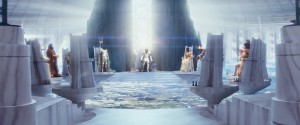 Scenes featuring Zeus and the other Gods pondering their future in Olympus involved external views as matte paintings. But interior shots, originally filmed on set with the actors, were heavily augmented by Framestore. “After the set was filmed,” said Webber, “it was decided to make the whole Olympus set much more grand and fantastical. We concepted it up, did some design work, and had some briefs from Nick Davis.” The Gods room was extended far off into the distance and the original floor, a marble representation of a 3D map was replaced. “We created a semi-photoreal landscape, sea and clouds floating above it, to make it seem like they were walking on a miniaturised version of Earth. When we were creating that, there was some concern that the audience would think that actually was Earth they were walking on, and whether the Gods were actually stepping on villages and in the sea. So we had to slightly pull back from the photorealistic aspect of it and add a lot of atmosphere and clouds and make it quite almost surreal. We generated clouds to cover it which wisp around the Gods’ feet. We created the walls all around them and replacing about 90 per cent of the set.” The room and Earth centre-piece were rendered as elements and composited in Nuke to fit the existing set.
Scenes featuring Zeus and the other Gods pondering their future in Olympus involved external views as matte paintings. But interior shots, originally filmed on set with the actors, were heavily augmented by Framestore. “After the set was filmed,” said Webber, “it was decided to make the whole Olympus set much more grand and fantastical. We concepted it up, did some design work, and had some briefs from Nick Davis.” The Gods room was extended far off into the distance and the original floor, a marble representation of a 3D map was replaced. “We created a semi-photoreal landscape, sea and clouds floating above it, to make it seem like they were walking on a miniaturised version of Earth. When we were creating that, there was some concern that the audience would think that actually was Earth they were walking on, and whether the Gods were actually stepping on villages and in the sea. So we had to slightly pull back from the photorealistic aspect of it and add a lot of atmosphere and clouds and make it quite almost surreal. We generated clouds to cover it which wisp around the Gods’ feet. We created the walls all around them and replacing about 90 per cent of the set.” The room and Earth centre-piece were rendered as elements and composited in Nuke to fit the existing set.
Armour worn by the Gods was also enhanced to provide a super-reflective and impossibly shiny glow. Noted Webber: “The armour became almost unreal in order to take it out of the world of normality. A lot of the 2D work went to designing that look and then achieving it – plus they all had slightly different looks! Then there was lots of atmospherics and beams of light coming through the room that were added with lens flares to make it a slightly unreal environment. This was a big challenge because a lot of the Gods had fuzzy hair and beards and we had to rotoscope them off one background onto another. It wasn’t planned like this and we would have shot on bluescreen and greenscreen, but we managed it in a few weeks.”
MPC – Pegasus, the Harpies, Argos and the Kraken
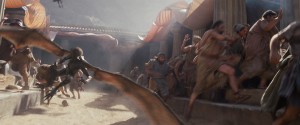 As Perseus makes his journey to Argos, he encounters Pegasus, a magical winged horse that he rides and battles on. Pegasus was realised by MPC as both a real horse with CG wings and as a fully digital creation for flying shots. “My biggest concern from the start,” said MPC visual effects supervisor Gary Brozenich, “was how we were going to track on the CG wings to this horse, especially knowing he would be running long distances on huge sets and landscapes. We needed to track CG wings onto him with a seamless join as CG flesh with live action flesh or fur. With the anisotropic specular quality that horses normally have, it made it even more difficult because the reaction of his highlights and his fur quality to light would change frame to frame – he’d pick up different colours from different angles from the sky and ground.” A test shoot with the real horse by DOP Peter Menzies was arranged to gauge different tracking materials and markings. A sheep spray proved to be unsuccessful in wet conditions and when the horse sweated, as did some prosthethic glue; although approved by all the necessary animal bodies, the glue tore some of the horses hair out. “It was quite a highly prized horse and typically when they get their hair pulled out, it will come back in a different colour. His fur tended to come back as white. So, the animal handlers eventually said we could glue a small piece of black vecro onto him and then use velcro tracking markers. We had pink velcro markers on him throughout the shoot and basically a bunch of witness cameras.”
As Perseus makes his journey to Argos, he encounters Pegasus, a magical winged horse that he rides and battles on. Pegasus was realised by MPC as both a real horse with CG wings and as a fully digital creation for flying shots. “My biggest concern from the start,” said MPC visual effects supervisor Gary Brozenich, “was how we were going to track on the CG wings to this horse, especially knowing he would be running long distances on huge sets and landscapes. We needed to track CG wings onto him with a seamless join as CG flesh with live action flesh or fur. With the anisotropic specular quality that horses normally have, it made it even more difficult because the reaction of his highlights and his fur quality to light would change frame to frame – he’d pick up different colours from different angles from the sky and ground.” A test shoot with the real horse by DOP Peter Menzies was arranged to gauge different tracking materials and markings. A sheep spray proved to be unsuccessful in wet conditions and when the horse sweated, as did some prosthethic glue; although approved by all the necessary animal bodies, the glue tore some of the horses hair out. “It was quite a highly prized horse and typically when they get their hair pulled out, it will come back in a different colour. His fur tended to come back as white. So, the animal handlers eventually said we could glue a small piece of black vecro onto him and then use velcro tracking markers. We had pink velcro markers on him throughout the shoot and basically a bunch of witness cameras.”
MPC artists used the witness camera data, matchmoves and roto-animation to lock in the movement of the horse and match muscle movement to a CG version of Pegasus modeled in Maya. “Our tech-anim team, led by Ceylan Skevket, was responsible for refining the roto animation to match the rig they had been provided with for the wings,” said Brozenich. “For the wing itself we had quite a detailed model built, but for the live action wing attachment there was separate rig. The wings were quite a basic piece of geometry with very elaborate rigging around the shoulder. The feathers were made from Furtility which is our fur dynamics software. Each individual feather was actually a groomed piece of Furtility output – it wasn’t geometry based in any way. It’s actually I-curves that are output and then rendered with specific fur shaders on them, which I think gave it a really good lustrous quality. And that fit perfectly with the real horse.” MPC animation supervisor Greg Fisher led the team in post-animating the wings on top of the real horse’s movements, with compositors finding the cleanest blends to bring the shots together.
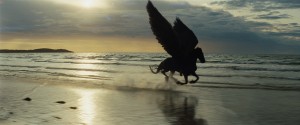 Perseus finally arrives at Argos for a confrontation with the Kraken as it emerges out of the nearby harbour to attack the city. Perseus and Pegasus attack the beast, but are themselves confronted by flying Harpies, winged bat-like creatures under the control of Hades. MPC completed the entire sequence, often entirely CG shots, starting with Aaron Sims character designs and production artwork. “We also had a team of previs artists and animators led by Paul Folker, and our in-house art director, Stephen Wong, fleshing out the sequence with Louis and Nick Davis,” said Brozenich. “There was actually a lot of live design sessions as we were previs’ing it. We were designing the layout of the city of Argos to accommodate the story line.”
Perseus finally arrives at Argos for a confrontation with the Kraken as it emerges out of the nearby harbour to attack the city. Perseus and Pegasus attack the beast, but are themselves confronted by flying Harpies, winged bat-like creatures under the control of Hades. MPC completed the entire sequence, often entirely CG shots, starting with Aaron Sims character designs and production artwork. “We also had a team of previs artists and animators led by Paul Folker, and our in-house art director, Stephen Wong, fleshing out the sequence with Louis and Nick Davis,” said Brozenich. “There was actually a lot of live design sessions as we were previs’ing it. We were designing the layout of the city of Argos to accommodate the story line.”
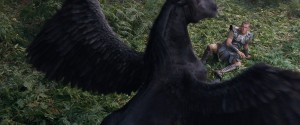 Early previs planning meant that design issues based on things like the wingspan of Pegasus and the Harpies could be accommodated in shot designs, especially given the proposed narrow streets of Argos. One such outcome led to the frenetic behavior of the Harpies. “We just had to keep in mind they wouldn’t be coming down to street level chasing the characters,” noted Brozenich. “So we came up with this way of thinking with the Harpies. They were like hyenas hunting in packs but would be out for themselves in that pack. But they also had a hyper-quality to them, constantly fidgeting and always looking over their shoulder. A bit like a junkie on the street, always on edge. We tried to make that work with how the set was being constructed in that the Harpies would never actually be able to fly slowly. They would constantly be going fast, almost without control. It forced them into an action where they would swoop down, try to grab hold of Perseus but then have to get themselves up and over the street to avoid an overpass, a bridge, canopies or whatever was on the set. That became part of their character.”
Early previs planning meant that design issues based on things like the wingspan of Pegasus and the Harpies could be accommodated in shot designs, especially given the proposed narrow streets of Argos. One such outcome led to the frenetic behavior of the Harpies. “We just had to keep in mind they wouldn’t be coming down to street level chasing the characters,” noted Brozenich. “So we came up with this way of thinking with the Harpies. They were like hyenas hunting in packs but would be out for themselves in that pack. But they also had a hyper-quality to them, constantly fidgeting and always looking over their shoulder. A bit like a junkie on the street, always on edge. We tried to make that work with how the set was being constructed in that the Harpies would never actually be able to fly slowly. They would constantly be going fast, almost without control. It forced them into an action where they would swoop down, try to grab hold of Perseus but then have to get themselves up and over the street to avoid an overpass, a bridge, canopies or whatever was on the set. That became part of their character.”
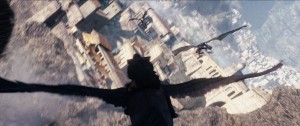 The Harpies themselves, which were also completed in some shots in the film by Framestore, resembled almost naked humans with sagging skin and muscle. The body of Iggy Pop was used as referenced. “These ripped muscular creatures are naked and raw and look like they had been aged and seen some damage,” said Brozenich. “Iggy was great reference because he’s so fit for someone his age, but his flesh hangs off him in a different way than someone who is say 22. Our head of rigging Tom Reed and lead rigger Ben Jones managed to get that looking right, and we used cloth simulation on a per-shot basis for the skin and wings.”
The Harpies themselves, which were also completed in some shots in the film by Framestore, resembled almost naked humans with sagging skin and muscle. The body of Iggy Pop was used as referenced. “These ripped muscular creatures are naked and raw and look like they had been aged and seen some damage,” said Brozenich. “Iggy was great reference because he’s so fit for someone his age, but his flesh hangs off him in a different way than someone who is say 22. Our head of rigging Tom Reed and lead rigger Ben Jones managed to get that looking right, and we used cloth simulation on a per-shot basis for the skin and wings.”
Previs also helped in designing and shooting on the physical Argos set, built at Longcross Studios in London. “So when we were doing the shoots,” said Brozenich, “we only had a rider, Sam Worthington, or a stunt rider running through the city. They were meant to be pursued by make-believe creatures with 200 extras who had to be performing to the action of something that wasn’t there. So we had to define the character before we went into the shoot to know how to guide the people on set, so they would know how to get out the way. We would have the AD come up to us and ask things like ‘How fast do these things go?’ and ‘Where is the Harpie right now!?’ We had to make sure people would drop to their knees on certain timings.”
The physical set was LIDAR scanned and provided a foundation for MPC set extensions and digital Argos.”We wanted to have the city as a separate asset just like our approach for the rest of the CG builds,” explained Brozenich. “This gave us much more flexibility. For instance, we have the Kraken. It’s a gigantic object, 700 feet above the water surface and no matter where he’s at he’s going to be casting a shadow over the city. So we decided from the start to make the city an asset, rather than a matte painting. We treated it as a normal 3D asset. That way we could re-light it, change the lighting direction, light it with the Kraken, without the Kraken and put all the characters in there. It fit within the pipeline.” MPC built some of the sections of the city in hi-res for shots of Pegasus and Perseus swooping down to within centimetres of city walls and streets as they are chased by the Harpies. In some shots MPC added CG crowds and even hero characters achieved through their Artificial Life Crowd Engine (ALICE) software, or using traditional mo-cap techniques.
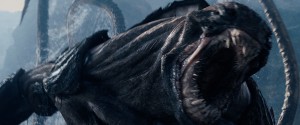 When the Kraken is finally unleashed, Pegasus and Perseus are seen flying in and around its tentacles trying to regain Medusa’s head from a rogue Harpie. “One thing that Louis was very keen on was pushing the camera animation,” said Brozenich. “He’s a very camera-driven director. He got stuck into those shots with us. It was meant to be like a roller coaster ride, really, which was the way we were describing it with him. He wanted to have these corkscrewing tentacles that Pegasus and Perseus were flying through because they were creating the jeopardy of the shot.” The Kraken’s tentacles were rigged using an FK approach, with the creature animated in Maya. “For rendering, our lookdev lead, Sheldon Stopsack, looked after all the material qualities of everything. The Kraken was covered in barnacles and incredibly hi-res textures. But at no point could you ever really see any particular detail that you would recognise, because as soon as you did that you would start judging him for his scale. We ended up somewhere between a whale’s skin and the way a human’s skin reacts. He had a rubbery quality and the scatter detail doesn’t penetrate him very deeply. What we found was that as soon as you see a great deal of scatter happening beneath the skin surface, that would again give him scale and make him feel small.”
When the Kraken is finally unleashed, Pegasus and Perseus are seen flying in and around its tentacles trying to regain Medusa’s head from a rogue Harpie. “One thing that Louis was very keen on was pushing the camera animation,” said Brozenich. “He’s a very camera-driven director. He got stuck into those shots with us. It was meant to be like a roller coaster ride, really, which was the way we were describing it with him. He wanted to have these corkscrewing tentacles that Pegasus and Perseus were flying through because they were creating the jeopardy of the shot.” The Kraken’s tentacles were rigged using an FK approach, with the creature animated in Maya. “For rendering, our lookdev lead, Sheldon Stopsack, looked after all the material qualities of everything. The Kraken was covered in barnacles and incredibly hi-res textures. But at no point could you ever really see any particular detail that you would recognise, because as soon as you did that you would start judging him for his scale. We ended up somewhere between a whale’s skin and the way a human’s skin reacts. He had a rubbery quality and the scatter detail doesn’t penetrate him very deeply. What we found was that as soon as you see a great deal of scatter happening beneath the skin surface, that would again give him scale and make him feel small.”
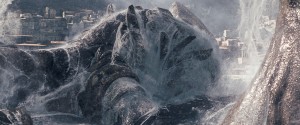 The initial unveil of the creature is a fully CG 40 second shot that shows the Kraken emerging from the ocean, spins around him and ends at his roaring face, all with a CG city, harbour and ocean in the background. Compositing of all those elements was supervised by Richard Baker and led by Stuart Lashley, with matte paintings and other environment work led by Yanick Bourgie. The shot also reveals water dripping from the Kraken’s tentacles, an effect necessitating a clear way of having fluids run over the body and tentacles of the creature. “We had effects passes flowing off of him,” said Brozenich, “but then we also came up with a really basic normals displacement method to give it a direction so that you had normals displacing in a direction and flowing over the surface which gave the impression of having water flowing off. Nigel Ankers, our effects lead, did an incredible job with the water simulations.” MPC used mostly Flowline and Maya to create the water surface, the water falling down and secondary foam and mist. Additional live action water elements were shot by dropping a two tonne black wedge into a tank at Pinewood Studios to create splashes, which were then added by compositors using a combination of Shake and Nuke.
The initial unveil of the creature is a fully CG 40 second shot that shows the Kraken emerging from the ocean, spins around him and ends at his roaring face, all with a CG city, harbour and ocean in the background. Compositing of all those elements was supervised by Richard Baker and led by Stuart Lashley, with matte paintings and other environment work led by Yanick Bourgie. The shot also reveals water dripping from the Kraken’s tentacles, an effect necessitating a clear way of having fluids run over the body and tentacles of the creature. “We had effects passes flowing off of him,” said Brozenich, “but then we also came up with a really basic normals displacement method to give it a direction so that you had normals displacing in a direction and flowing over the surface which gave the impression of having water flowing off. Nigel Ankers, our effects lead, did an incredible job with the water simulations.” MPC used mostly Flowline and Maya to create the water surface, the water falling down and secondary foam and mist. Additional live action water elements were shot by dropping a two tonne black wedge into a tank at Pinewood Studios to create splashes, which were then added by compositors using a combination of Shake and Nuke.
The final shot count for Clash of the Titans ran into the many hundreds, with a host of other vendors also involved in delivery. It was also decided at a late stage in post-production to release the film in 3D. Dimensionalisation efforts were handled by Prime Focus, with effects vendors providing mattes, masters, original plates and rendered layers where possible.
